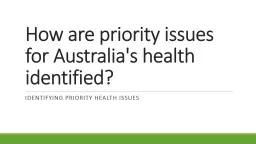PPT-IDENTIFYING PRIORITY HEALTH ISSUES
Author : pamella-moone | Published Date : 2019-02-05
Students lean about Social justice principles Priority population groups Prevalence of condition Potential for prevention and early intervention Costs to the individual
Presentation Embed Code
Download Presentation
Download Presentation The PPT/PDF document "IDENTIFYING PRIORITY HEALTH ISSUES" is the property of its rightful owner. Permission is granted to download and print the materials on this website for personal, non-commercial use only, and to display it on your personal computer provided you do not modify the materials and that you retain all copyright notices contained in the materials. By downloading content from our website, you accept the terms of this agreement.
IDENTIFYING PRIORITY HEALTH ISSUES: Transcript
Download Rules Of Document
"IDENTIFYING PRIORITY HEALTH ISSUES"The content belongs to its owner. You may download and print it for personal use, without modification, and keep all copyright notices. By downloading, you agree to these terms.
Related Documents














